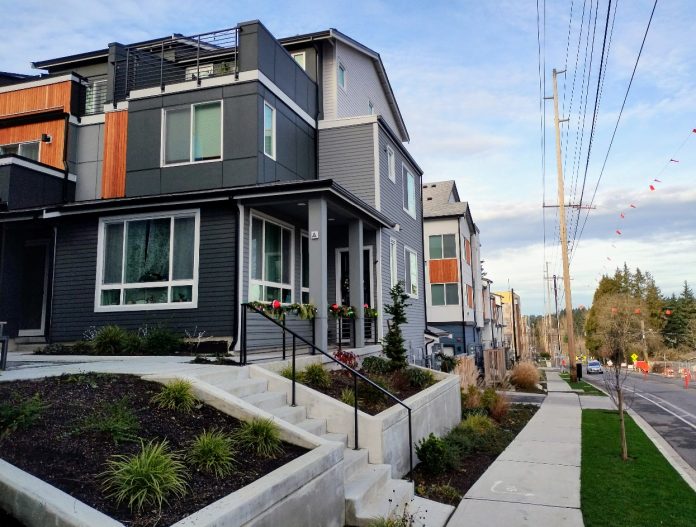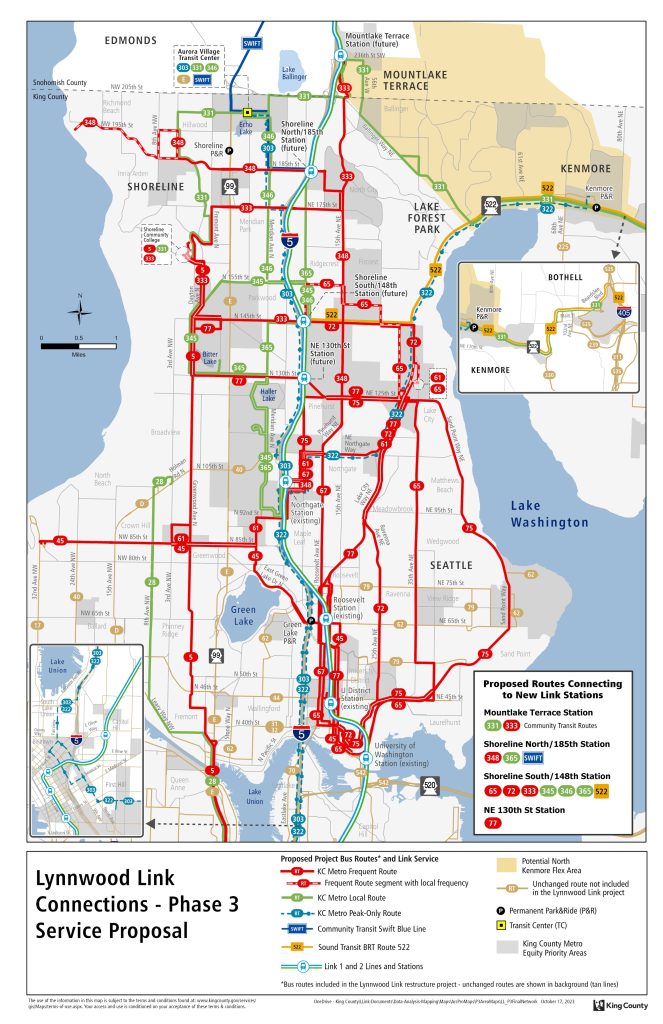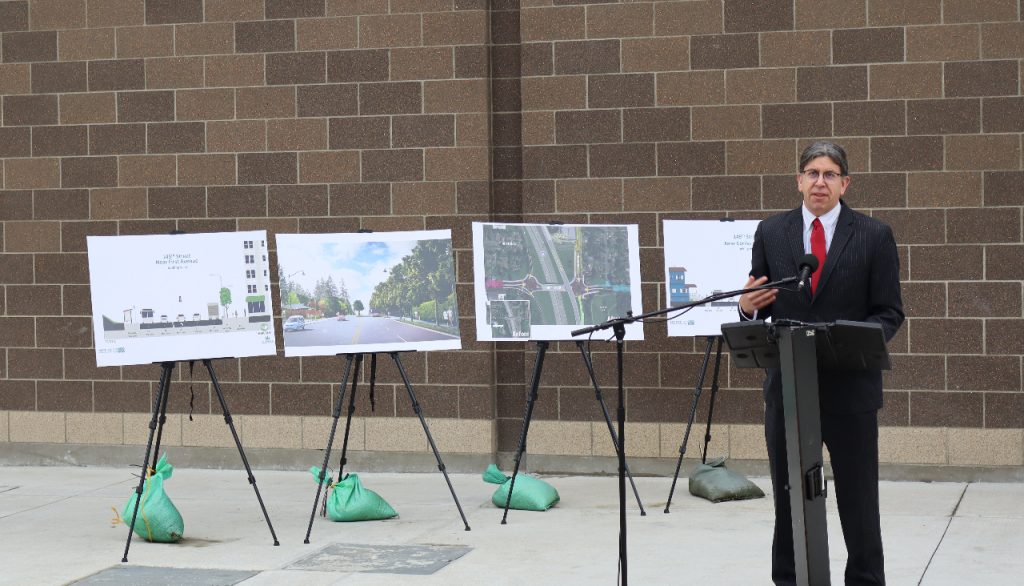
The Shoreline City Council showed reluctance this week to allow denser development in single family neighborhoods, appearing satisfied to restrict the city’s housing boom to its two light rail stations, which are set to open on August 30. While Shoreline’s planning commission and its City staff had been pushing to go further than the minimum housing requirements set by the state, Monday night’s conversation suggested that some level of development fatigue is setting in for the Shoreline Council.
The conversation centered on Shoreline’s Comprehensive Plan update due by the end of 2024, setting the stage for where the city will concentrate housing and jobs over the next ten years. Shoreline, like cities across the state, is grappling with how to implement 2023’s House Bill 1110, which increases the minimum level of allowed density in single family zones in most urban areas. As a city between 25,000 and 75,000 people, Shoreline will have to allow property owners to build two units on all residential lots, and four units within a quarter-mile of a major transit stop. In Shoreline’s case, Link light rail and RapidRide E will be the HB-1110 qualifying routes, but Shoreline is set to receive a boost to King County Metro service via a fall bus structure paired with the Lynnwood Link extension.

At just under 62,000 residents, Shoreline isn’t likely to be pushed above 75,000 by growth in the next few years, but it may be headed that way in the decade ahead. Once it crosses the 75,000 mark, the City’s next Comp Plan update would have to allow six units to be built on all lots close to transit and four units everywhere else, but Shoreline’s planning commission signed off earlier this month on going further than the baseline requirements in HB 1110.

The “Tier 2.5” option developed by Shoreline city staff would have expanded the footprint of lots required to allow four units to within a half-mile of transit, greatly expanding the potential reach of “missing middle” multiplexes on either side of Aurora Avenue N and further out from the 148th and 185th Street light rail stations. It also would have allowed fourplexes on lots within a quarter mile of “activity centers” — commercial districts that do have some transit but not to the level where changes would be required by HB 1110.
If approved, this would mean approximately 70% of the total parcels in Shoreline would see their zoning changed to allow fourplexes, compared to just 16% if the city complied with the bare minimum requirements in HB 1110.
“This option also supports a common theme heard throughout community engagement, which highlighted a strong interest by the community to be able to live near neighborhood centers that offer services and amenities,” the staff report noted.


Instead, what looked to be close to a majority of the Shoreline City Council expressed a desire to scale things back, closer to the minimum required by state law. Several councilmembers said that the city had already done enough by allowing substantial amounts of housing growth around light rail stations. Between 2019 and 2023, Shoreline saw more than 4,000 units permitted, much of which will be built near the soon-to-open light rail stations — though the Aurora Avenue corridor is seeing a boom as well.
“It’s undeniable that Shoreline as a city is doing our bit, and have been,” Councilmember Betsy Robertson said. “I think taking into account how much has been done already, I would like to see us settle into the development and the growth that has already taken place before going to the top of the class.”
“After decades and decades of not growing at all, as a community — I think we were stuck at 50,000 for 30 years, pretty much — we are now growing very rapidly, and I can understand how people who have been here for a while are just looking around, with their head spinning,” Councilmember John Ramsdell said. Ramsdell said listening to the testimony of public commenters earlier in the evening, many of whom had raised concerns about seeing their neighborhoods change significantly, had caused him to want to scale things back from what the planning commission recommended.

“I’m very concerned about opening up most of the city to middle housing. I do not believe that was the intent of the legislature with House Bill 1110,” Councilmember Annette Ademasu said. The original version of HB 1110 would have required Shoreline to allow four units on all lots in Shoreline, and six units near transit, a change that Seattle will be implementing on the other side of the city limit at 145th Street — minus a Harrell Administration plan to carveout up to 15% of single family zones due to displacement concerns.
Ademasu said she would support fouplexes within a half mile of light rail, and close to the neighborhood activity centers, but seemed to question the need for Shoreline to add so much density. “Less dense housing has been shown to have better health outcomes, both mentally and physically,” she said. Ademasu joined the council just this year, and did not have a role in the previous land use decisions that opened up the light rail walksheds to the added housing density.
Councilmember Keith Scully framed HB 1110 as steering Shoreline away from its previous plan to keep the rest of its city unchanged while it focused development around the Sound Transit stations.
“Our decision to concentrate development around light rail and not elsewhere, that’s off the table,” Scully said. “We can’t do that anymore. We have to do both.”
Scully said his emphasis will be on ensuring that neighborhoods that see more Missing Middle development don’t see much aesthetic changes by requiring the newly allowed types of housing to look like what exists today, primarily by limiting the amount of a lot that can be developed as “hardscape.” That could mean that on paper a fourplex is allowed, but in reality doesn’t make sense to develop because tight restrictions on how much of a lot can be occupied make most fourplex designs infeasible.

In contrast, Mayor Chris Roberts spoke in favor of increasing density as a pathway to achieving the goals that Shoreline has set for itself, noting that any zoning changes would take a long time to be fully realized.
“This is our vision for the city. This is a desire for what we would like to see,” Roberts said. “Just because we have a particular zone or a particular vision for a spot, does not mean something actually gets developed. When we look at places that have adopted robust middle housing standards, whether it’s Minneapolis or we look to our friends in Spokane, just because it’s zoned for more units, at the end of the day does not mean that something will actually get developed. And I think we have to start there, in thinking about what our vision ought to be, and what it should actually look like.”
Roberts noted that he believed there was a consensus on the Shoreline Council to create more walkable communities, but when it came to taking the steps to implement that it was a different story. “That’s the goal, that’s the vision, that’s what we can all agree on. When we have to put our policy hats on, then we get a little bit — I hear squeamishness.”
Monday’s exchange appeared to show the limits for a city council that has whole-heartedly embraced transit-oriented development in anticipation of light rail, even as it’s received pushback, particularly over the issues of tree retention and traffic congestion. While a final vote is still many months away, many Shoreline councilmembers appear to prioritize “neighborhood character” and freezing much of the city in amber ahead of addressing the pressing housing crisis that is burdening families across the region.
Ryan Packer has been writing for The Urbanist since 2015, and currently reports full-time as Contributing Editor. Their beats are transportation, land use, public space, traffic safety, and obscure community meetings. Packer has also reported for other regional outlets including BikePortland, Seattle Met, and PubliCola. They live in the Capitol Hill neighborhood of Seattle.

